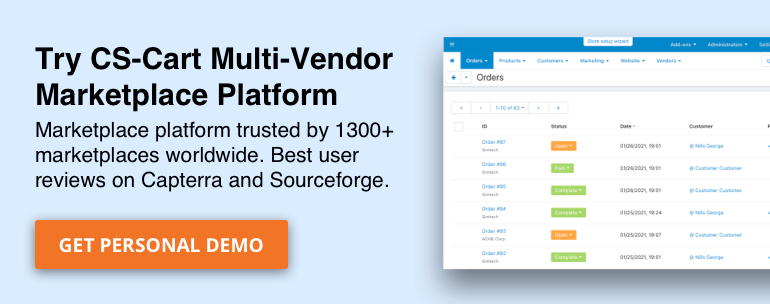Is Shifting from a Single Vendor eCommerce Store to a Multi-Vendor Marketplace Beneficial?

 | Astha Sharma is a senior content writer at MAAN Softwares INC. She has been writing for various companies for over 4 years on a variety of topics. Astha specializes in technical writing with an emphasis in mobile development, web design, and technology trends. Astha finds covering the tech world to be an exciting and engaging experience as each day brings new and groundbreaking technologies to explore and write about. When she’s not writing about tech, she enjoys walking her two chihuahua-poodle mixes, Ginger and Pepper. |
During the year, 1995 to 2008, we observed that a large global marketplace had come into existence that sold baby milk powder to second-hand cars. They grew fast because of their voluminous offerings. Further, in the year 2009, the landscape of the marketplace took a shift, as new market players breached in with industry-specific approach.
Shopping malls have declined in the last few years, in contrast, online retails, are still alive and well with generous return policies, ease of mobile payments, and many more. Since online marketplaces have disrupted the traditional businesses and the traditional middleman as online marketplace provides more transparency and direct access to different sectors.
Seeing online marketplace model grow abundantly like Amazon quintuple, offline retails has been forced to move towards this integration to build their online presence. This combination of online and offline retail gives an extensive opportunity for the new marketplace, engaging more and more customers who would either see a desired product online or buy it.
Further, we hope to see potential growth in B2B eCommerce. In a survey, eMarketer believes that B2C will be worth $4 trillion by 2020, whereas, Forbes believes B2B eCommerce will be worth $6.7 trillion. These multi-vendor marketplaces like Alibaba, Amazon, AliExpress and many more has fundamentally changed the perception of people in global trade sourcing the best & cheapest products along with driving cost-efficiency.
So, to take your existing business to the next level, you must consider shifting your single-vendor store to a marketplace business model.
You may also be interested:
Top multi vendor marketplace platforms 2021
Multi-Vendor Market Approach
In this highly competitive niche, organizations want the best solutions to deliver to both in-house staffs as well as customers who want a piece of streamline information along with a 24/7 support. If not managed properly, multi-vendor engagement can become expensive and time-consuming. Thus, Multi-Vendor approach lowers the risk of vendor lock-in, more technology choices, as well as lower total cost of ownership for better negotiation with small vendors.

With the changing business requirements and new technology landscape, businesses today need greater agility and flexibility. Earlier, there was a common place for one large service provider to manage multiple areas of IT like—application development, maintenance, and support. Organizations have distributed outsource engagement into diverse parts to access niche expertise, enhance the quality of services, and redefine cost structures.
How does a Multi-Vendor Marketplace Model Work?
For the service providers to achieve the desired objective, an effective governance mechanism is necessary. This mechanism integrates project management efforts with adequate tools, processes, and methodologies which helps an overall aggregate-level insight into services delivered.

A multi-vendor marketplace offers a web platform to set a digital commerce network that helps assist an active and powerful communication between sellers and customers. This process reduces the headache of the marketplace owner, as the consumer directly connects with the seller for a particular product when ordered, the marketplace owner collects his share of profit.
Just the way in a music concert, the musical conductor guides and communicate the instruction to the performers in order to achieve the right melody, multi-vendor structure glides services to the team who can further guide the companies to smoothen the complexities, risks, and integration issues.
Thus, without proper preparation & knowledge, the very objective of the multi-vendor relationship model can go off-track.
You also need to keep in mind that every multi-vendor online mall requires a reliable base—a marketplace software solution that has all the necessary functionality, such as CS-Cart Multi-Vendor.
- Financial management tools compare the actual performance of the budget, the ability to manage penalties and incentives.
- Performance management tools help provide a single, unified view of the performance of the multiple vendors to measure and compare their service levels.
- Compliance management tools help in viewing the end-to-end processes with their dependencies on all vendors.
Why Should You Choose the Multi-Vendor Marketplace (E-Commerce)?
So, what are the benefits of marketplace model? To display the products and services and reach maximum audience convert your basic eCommerce website into a multi-vendor marketplace, which would be more powerful, flexible and swift.

Below mentioned are the elaborated benefits of a multi-vendor marketplace for the business, customer, and supplier.
Seller’s Benefits
- Small vendors catering to the local market will have the opportunity to showcase their products to a larger audience.
- Another benefit is that the product’s price received from different vendors can be standardized according to their quality.
- Having multiple suppliers is an added advantage if, any taken away by the competitive marketplace or running through financial loss, can always rely on other suppliers.
- During the demand fluctuation, a seller can choose his/her choice of suppliers.
Customer Benefits
- Customers benefit out from multiple suppliers as they provide them with a wide variety of options.
- Vendors, to improve their sales, put offers that attract more users which parallelly benefits consumers in picking more.
- With the help of reviews and ratings, the customer gets the best product from comparing in the competitive marketplace.
Supplier Benefits
- No more thinking of the budget or marketing capacity because software can help them in joining the marketplace with bigger businesses.
- More clarity to these market vendors along with many fulfilling options.
- A valuable and reliable platform to channelize with an international online marketplace to sell products and services.
A Commonality of Objective, Equality in Outcome
It is difficult to make all the service providers view a common objective for the success of the multi-vendor initiative. Thus, organizations are specifying some incentives for the success of a combined result. Having a common goal will encourage to push each vendor’s effort in the same direction with a strong bond amongst for the growth of all. Also, it is beneficial for the shopper, as they will experience an enhanced level of shopping where he/she can grab the opportunity in both the hands.
More useful eCommerce articles and infographics are coming your way. Follow CS-Cart on Facebook and Twitter not to miss them!

Yan Anderson is the Head of Content Marketing at CS-Cart with over 10 years of experience in the eCommerce industry. He's passionate about explaining complicated things in simple terms. Yan has expertise in building, running and growing eCommerce marketplaces. He loves to educate people about best practices, new technologies, and trends in the global eCommerce industry.

